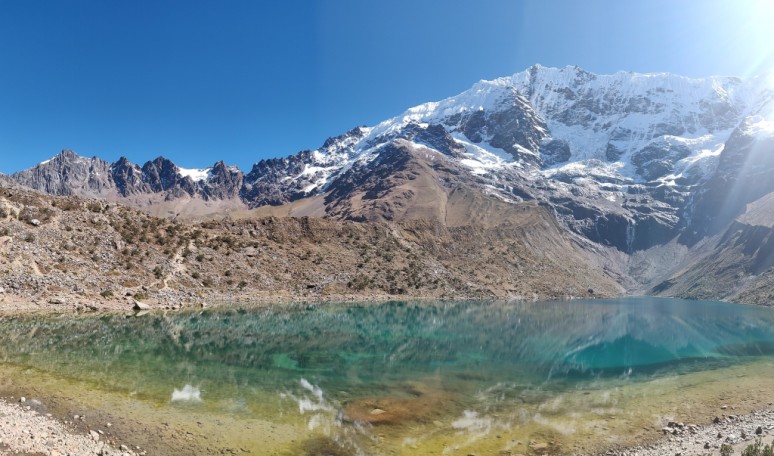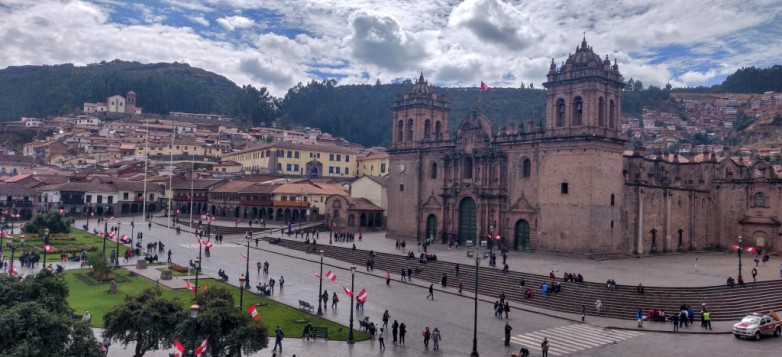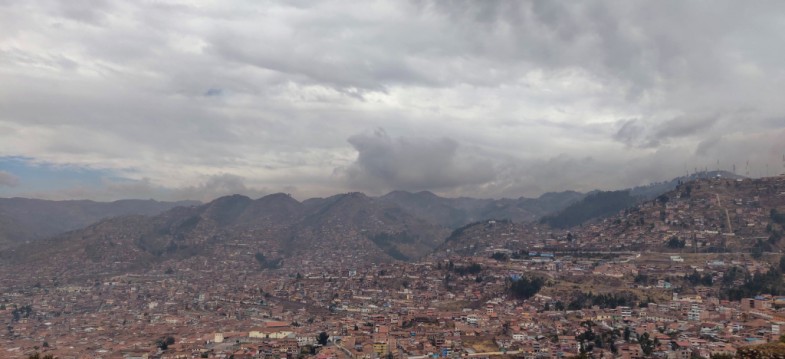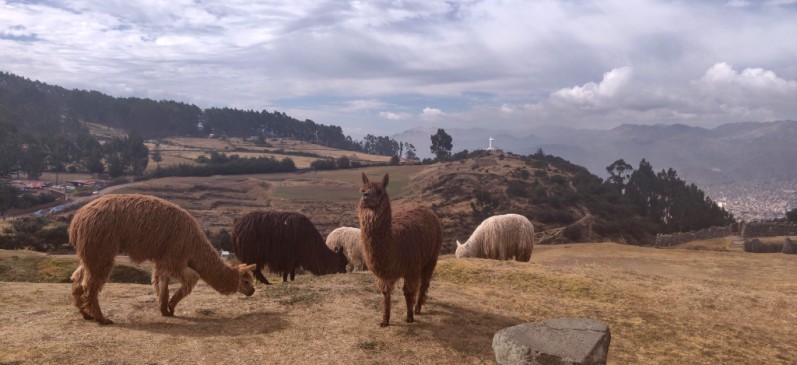
Peru: Lake Humantay, Rainbow mountain and Cusco
I arrived at my hotel in Cusco, greeted by a sleep deprived man who wanted to change his room in case it was possible and the bleary-eyed hotel staff. Once in my room, I fell asleep quickly, only to wake up in a few hours to head out on my day trip to the Humantay lake, situated at a whopping 4200m above sea level. I had read nasty things about altitude sickness. Since I had not spent enough time in Cusco yet, I was extremely worried if I would be able to hike up all the way, so much so that I was unable to get any sleep on the bus ride that lasted more than three hours. We stopped for breakfast on the way at what seemed like a private residence in a place called Mollepata. For the first time since I had arrived in Peru, I was feeling alone and left out, seated with groups of people who seemed to know each other and did not wish to make any new friends. As our bus chugged up the mountain, I kept a check on myself, concentrating hard to make sure I was not feeling uneasy. I think all the worry was enough to make me sick.

The guide gathered us at the beginning of the hike and named us the “slow potatoes”, quite aptly guessing our abilities, I must say. I haughtily said I would not need a hiking pole that he graciously offered, but a girl in our group made sure I took it. I would be grateful for that a little while later. After walking on level ground and savoring the majestic beauty of the snow-covered mountains around us for a few minutes, the steep climb began. I was the slowest amongst the slow potatoes, stopping to take a breath after every ten steps or so. It did not help that I was left so far behind everybody else that I got lost, trying to follow some people who were taking a much harder route than what I had signed up for. The guide came back looking for me and accompanied me all the way to the end. I was exhausted and feeling embarrassed about all the trouble. It was bright and sunny when we finally reached the lake nearly an hour and 45 minutes since we started. The turquoise blue waters against the backdrop of the mountains was as picturesque as it could get, quickly erasing from our minds all the struggle it took us to get there. It is a glacial lake fed by the snow from the Humantay mountain and was allowed access to earlier. Not anymore since the authorities realized it is polluting the crystal-clear waters. Any number of photos would not leave us content. There were a few people staying away from the race for the perfect click, calmly staring at the lake, probably wondering if it is emerald or turquoise. I wish I could join them, but we were allotted only so much time and I had to see the lake from every angle possible. I was too late and hungry (since they gave us only non-vegetarian sandwiches) to try and climb up a nearby hill to get a better view. The guide explained something about a ritual that is performed only by virgin women and seemed to ask everybody if they were a virgin, eliciting animated responses, mostly shocked that he deemed it all right to ask something so personal.

Soon, we were on our way down. Unlike the way up, I was running. I befriended a hedge fund analyst from Boston (or New York?) and the conversation kept us distracted, just enough to lose the way a little bit. We were quick to realize our mistake though and were back at the trailhead before most people in the group made it. He showed me pictures from his 5-day Salkantay trek to Machu Picchu, each one better than the other. I regretted not having chosen to do it, but that would have meant a much more hectic trip with hardly any time for any activities apart from the trek. It was easier to doze off on the ride back. We stopped at the same place for lunch. I was served a whole lot of sautéed vegetables to make up for the exquisite dishes made of different kinds of meat. As soon as I made it back to the hotel room, my head would not stop hurting. That was the altitude sickness. I was glad it showed up now rather than while I was hiking. Too tired to go out into the city again, I skipped dinner, popped some painkillers and caught up on all the sleep I had lost.

The next day started pretty much the same way, losing my cap in a taxi making it slightly worse. We were headed to the rainbow mountain, so called because of the colors you can see on the mountain. The elevation is 1000m more than the lake – 5200m. Another girl who waited with me for the bus broke the ice introducing herself, much to my relief. She had travelled from Mexico, all by herself too. She had got back from the five-day trek to Machu Picchu too, but did not look exhausted. Someone getting off the bus because he was feeling sick had me worried again, wondering if I should really go ahead or get off the bus. I was grateful there were caps for sale at the place where we stopped for food and also that I had company, not letting the Mexican girl eat alone in peace. Most of us pocketed some coca candy as well as it was touted to help with altitude sickness. It was cloudy, making it extremely cold when we got off the bus to start the hike.


Although the hike was not all that long or strenuous, at that altitude, every step I took was an accomplishment. Just like the previous day, I was left far behind the rest of the group within no time. I was not worried I would get lost though, since more tourists seemed to have chosen to see the rainbow mountain rather than the Humantay lake, making it much more crowded. One girl in our group took a horse ride until the gradual ascent turned into a steep one about an hour into the hike. She got off and offered to keep me company, citing how “hiking is not a thing where I come from”. I would be lying if I said I was not insulted, considering myself to be quite the hiker now a days. I quickly made the climb to a spot right before a few steps to the final viewpoint and started feeling extremely sick. The tour guide made me inhale something that immediately made me feel much better. Unfortunately, I cannot recall what it is now and no amount of googling seems to help. For the first time this year, I did not complete a hike. What hurt was that the peak I had to get to was right in front of me, just a few minutes’ climb, but I simply could not bring myself to do it. So near, yet so far! I sat there for a while contemplating. Some others who needed oxygen masks to breathe made me feel slightly better about myself, but not enough to attempt the climb. It seemed like my head would split if I gained any more elevation. I could have avoided it had I spent enough days in Cusco before starting all these hikes. I wondered why nobody ever spoke about altitude sickness while traveling in India to spots at nearly the same elevation. Probably the awareness makes it worse these days. Back then, we did not plan and prepare so much before heading on a trip. I made myself useful while waiting for the others in the group to get back and clicked pictures for many others.

The walk back was breezy and I rushed, but my head felt much heavier once we got to the bus. We were on our way down within no time and I felt perfectly normal as we pulled up to the same place where we had breakfast, for lunch. The only friend I made on this day had seated herself with the others and did not invite me to join. I was slightly intimidated and did not approach them either. So, here I was, feeling lonely and left out on a solo trip, just like the previous day. All worries aside, I was simply glad I got away with a headache and nausea. I had heard stories of it being much worse and of people flown to Lima, which is at a much lower altitude than Cusco. It is probably this thought that prompted me to tip the guide a handsome sum once we got off the bus at Cusco.

Without a hint of exhaustion, I strolled around the Plaza de Armas, the main square of Cusco, taking us back a few centuries with many Spanish colonial buildings raised by destroying the Inca structures still intact. It is now a commercial hub with a lot of inviting shops around. I got some Peruvian chocolates and helped myself to some ice cream out of the myriad flavors, some of which I can now remember are chicha morada (a drink made of corn), custard apple and the like, although it got chillier. I walked back to the hotel around sunset enjoying the sights of a market which still seemed abuzz.


The last day of my trip was kept aside to explore Cusco. I did not have an itinerary and decided to go by the suggestions of my friends from the Machu Picchu trip and other recommendations online. I hailed a taxi quite early in the morning to go to Sacsayhuaman, the archaeological site located on a hill that overlooked Cusco. As I had noticed earlier, there was not enough information displayed about the site and most people relied on guides, but I preferred not to since I wanted to spend as much time as possible here without any constraints. The structures there are astonishing to say the least, built with huge stones that fit together perfectly well. This is a true testimony to the architectural prowess of the Incas, even more so than Machu Picchu itself, in my opinion. The zigzag walls elicited such amazement from the Spaniards that they thought only demons could have built something like this. I walked around the site to get some beautiful views of Cusco that made me realize the city was not as small as I thought it was, glad that there were not many people around that early. That changed quickly though, with swarms of tourists and school kids flocking around.


While I sat down enjoying the views and the company of some Llamas, this man who introduced himself as an artist from a poor Quechua family near Cusco talked me into buying a stone show piece of the Condor, Puma and Snake – the Inca trilogy which he apparently carved himself. I was not all that convinced, but bought it because I did plan on buying something like that. He asked me to hide it in my bag since it was illegal for him to be selling anything within the site. I walked to take a look at the Cristo Blanco, a miniature “Christ the redeemer” after that and was back in Cusco. Lunch at a trendy vegan place and I was good to go for a few more hours. I spent some time at the Cusco cathedral where the one thing that stands out is the Peruvian take on the last supper – Jesus and his disciples dining on guinea pig et al. Shopping at the Centro Artesanal for trinkets and then strolling around the San Pedro market drove me to so much weariness that I decided to call it a day.

I traveled back the next day, taking with me not just some words of Spanish and souvenirs, but a whole lot of courage that I can travel anywhere because people are the same no matter where you go, trying to shower us with kindness while educating us about their land and culture which they are truly proud of. And some amount of regret that the people in charge do not care about the earth or the history, only motivated to make money out of everything. Would they stop if tourists stopped visiting these places?